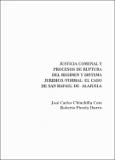| dc.contributor.author | Chinchilla Coto, José Carlos | |
| dc.contributor.author | Pineda Ibarra, Roberto | |
| dc.date.accessioned | 2020-11-04T06:08:27Z | |
| dc.date.available | 2020-11-04T06:08:27Z | |
| dc.date.issued | 1999-12 | |
| dc.identifier.issn | 2215-2997 | |
| dc.identifier.other | https://www.revistas.una.ac.cr/index.php/abra/article/view/4295/4137 | |
| dc.identifier.uri | http://hdl.handle.net/11056/18529 | |
| dc.description.abstract | El artículo trata de efectuar una
propuesta analítica multidimensional sobre
dichos procesos y aporta una descripción
de cómo tienden a ser interpretados en las
diversas instancias y por los diversos sujetos; tanto en la dimensión societaria como en la societal; es decir, por parte de las
comunidades en las cuales se pre-sentan
dichas situaciones; así como también en la
comunidad nacional, por los sujetos actores directos del proceso como por los
agentes del estado, del poder político y de
la llamada opinión pública.
En función de este interés, analizamos lo ocurrido a la comunidad de San
Rafael de Ojo de Agua, cuando en ella se
instaló una fábrica de harina de pescado,
que vino a modificar la calidad de vida de
los habitantes y algunas de las prácticas
cotidianas en la comunidad; hasta el punto
de transformar un pueblo de origen campesino y de gente pacífica, en verdaderos
luchadores de lo que ellos definieron como
sus derechos. | es_ES |
| dc.description.abstract | The article tries to make a
multidimensional analytical proposal on
these processes and provides a description
of how they tend to be interpreted in the
different instances and by the different subjects; both in the corporate and in the societal dimension; that is, by the
communities in which they are
such situations; as well as in the
national community, by the subjects that are direct actors in the process as well as by the
agents of the state, political power and
the so-called public opinion.
Based on this interest, we analyzed what happened to the community of San
Rafael de Ojo de Agua, when he was
installed a fishmeal factory,
that came to change the quality of life of
the inhabitants and some of the practices
in the community; to the extent that
to transform a village of peasant origin and peaceful people into a true
fighters of what they defined as
your rights. | es_ES |
| dc.description.sponsorship | Universidad Nacional, Costa Rica | es_ES |
| dc.language.iso | spa | es_ES |
| dc.publisher | Editorial de la Universidad Nacional | es_ES |
| dc.rights | Acceso abierto | es_ES |
| dc.rights.uri | http://creativecommons.org/licenses/by-nc-sa/4.0/ | * |
| dc.source | Revista ABRA Vol. 20, No. 29, p. 57-70 | es_ES |
| dc.subject | COSTA RICA | es_ES |
| dc.subject | ALAJUELA (COSTA RICA) | es_ES |
| dc.subject | SAN RAFAEL (ALAJUELA) | es_ES |
| dc.subject | SOCIOLOGÍA JURÍDICA | es_ES |
| dc.subject | LEGAL SOCIOLOGY | es_ES |
| dc.subject | PARTICIPACIÓN COMUNITARIA | es_ES |
| dc.subject | COMMUNITY PARTICIPATION | es_ES |
| dc.subject | JUSTICIA SOCIAL | es_ES |
| dc.subject | SOCIAL JUSTICE | es_ES |
| dc.title | Justicia comunal y procesos de ruptura del régimen y sistema jurídico/formal: el caso de San Rafael de Alajuela | es_ES |
| dc.title.alternative | Communal justice and processes of rupture of the regime and legal/formal system: the case of San Rafael de Alajuela | es_ES |
| dc.type | http://purl.org/coar/resource_type/c_6501 | es_ES |
| dc.description.procedence | Escuela de Sociología | es_ES |


